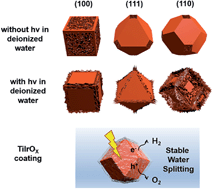Shape effects of cuprous oxide particles on stability in water and photocatalytic water splitting†
Abstract
Cuprous oxide (Cu2O) has received much attention as a photocatalyst due to its direct band gap structure, small band gap energy, non-toxicity, and abundance. However, Cu2O usually suffers from poor stability because the oxidation state of copper is easily changed. In this work, Cu2O particles of three different shapes were prepared with distinct surface structures: cubes with (100) facets, octahedra with (111) facets, and rhombic dodecahedra with (110) facets. Their shape stability was estimated in deionized water with or without light irradiation. The Cu2O(100) facets were selectively deformed under dark conditions, as expected from density functional theory calculations. The rhombic dodecahedra showed the most violent degradation under light irradiation, with many large thorns appearing on the surface. When water splitting was attempted using the shaped Cu2O particles, the rhombic dodecahedra produced the most hydrogen, whereas the cubes produced none. Oxygen was not measured because the holes generated upon light absorption were used to oxidize the Cu2O surface to CuO. A conformal TiIrOx overlayer was successfully formed on the rhombic dodecahedral Cu2O particles, and the coated particles presented overall water splitting producing both hydrogen and oxygen. They also showed significantly improved stability over repeated water splitting reactions relative to bare Cu2O particles or TiOx-coated Cu2O particles.


 Please wait while we load your content...
Please wait while we load your content...